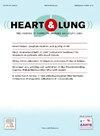插管和低氧血症对早产儿第一周脑室内出血的影响:观察研究。
IF 2.4
4区 医学
Q2 CARDIAC & CARDIOVASCULAR SYSTEMS
引用次数: 0
摘要
背景:早产儿脑室内出血(IVH)有可能导致神经发育障碍。很少有研究探讨氧饱和度(SpO2)变化和插管程序对 IVH 风险的影响:我们研究了早产儿在新生儿重症监护室(NICU)的第一周内插管和三种低氧血症阈值对 IVH 发生率的影响:在这项前瞻性观察队列研究中,胎龄(GA)为2的早产儿发生了变化,并使用头颅超声波检查来监测IVH。结果:所有早产儿(N = 73)的平均胎龄为 31.55 周,平均出生体重为 1508.86 克。出生后 3 天内插管、机械通气和吸氧持续时间、低氧血症发生率以及产妇在分娩前和分娩过程中使用硫酸镁与 IVH 显著相关。多变量分析显示,在不同的低氧血症阈值下,插管是与 IVH 发生相关的关键因素(p = 0.004):结论:尽管低氧血症发生率、机械通气和吸氧持续时间以及产妇使用硫酸镁与 IVH 有显著相关性,但分娩后 3 天内插管是导致 IVH 风险增加的关键因素。本文章由计算机程序翻译,如有差异,请以英文原文为准。
Effects of intubation and hypoxemia on intraventricular hemorrhage in preterm infants during the first week: An observational study
Background
Preterm infants with intraventricular hemorrhage (IVH) are at a risk of developing neurodevelopmental disabilities. Few studies have examined the effects of oxygen saturation (SpO2) changes and intubation procedures on the risk of IVH.
Objectives
We examined the effects of intubation and the rates of three thresholds of hypoxemia on the occurrence of IVH in preterm infants during their first week in the neonatal intensive care unit (NICU).
Methods
In this prospective observational cohort study, preterm infants with a gestational age (GA) of <37 weeks were included from two Level III NICUs in Taiwan. Continuous electrocardiography was used to monitor SpO2 changes, and cranial ultrasonography was used to monitor IVH. Thresholds of hypoxemia (SpO2 levels of <80 %, <85 %, and <90 %) were screened by digitally sampling data at 10-s intervals. Generalized estimating equations were used with logistic regression to analyze the effects of intubation and the rates of the three thresholds of hypoxemia on the risk of IVH during the first week after birth.
Results
In all preterm infants (N = 73), the mean GA was 31.55 weeks, and the mean birth weight was 1508.86 g. Intubation within 3 days of birth, duration of mechanical ventilation and oxygen use, hypoxemia rate, and maternal use of magnesium sulfate before and during delivery were significantly associated with IVH. A multivariate analysis revealed that intubation was a key factor associated with the occurrence of IVH across different thresholds of hypoxemia (p = 0.004).
Conclusions
Although the rate of hypoxemia, duration of mechanical ventilation and oxygen use, and maternal use of magnesium sulfate were significantly associated with IVH, intubation within 3 days of birth was the key factor responsible for increased IVH risk.
求助全文
通过发布文献求助,成功后即可免费获取论文全文。
去求助
来源期刊

Heart & Lung
医学-呼吸系统
CiteScore
4.60
自引率
3.60%
发文量
184
审稿时长
35 days
期刊介绍:
Heart & Lung: The Journal of Cardiopulmonary and Acute Care, the official publication of The American Association of Heart Failure Nurses, presents original, peer-reviewed articles on techniques, advances, investigations, and observations related to the care of patients with acute and critical illness and patients with chronic cardiac or pulmonary disorders.
The Journal''s acute care articles focus on the care of hospitalized patients, including those in the critical and acute care settings. Because most patients who are hospitalized in acute and critical care settings have chronic conditions, we are also interested in the chronically critically ill, the care of patients with chronic cardiopulmonary disorders, their rehabilitation, and disease prevention. The Journal''s heart failure articles focus on all aspects of the care of patients with this condition. Manuscripts that are relevant to populations across the human lifespan are welcome.
 求助内容:
求助内容: 应助结果提醒方式:
应助结果提醒方式:


